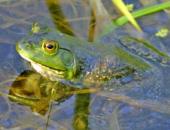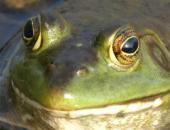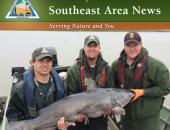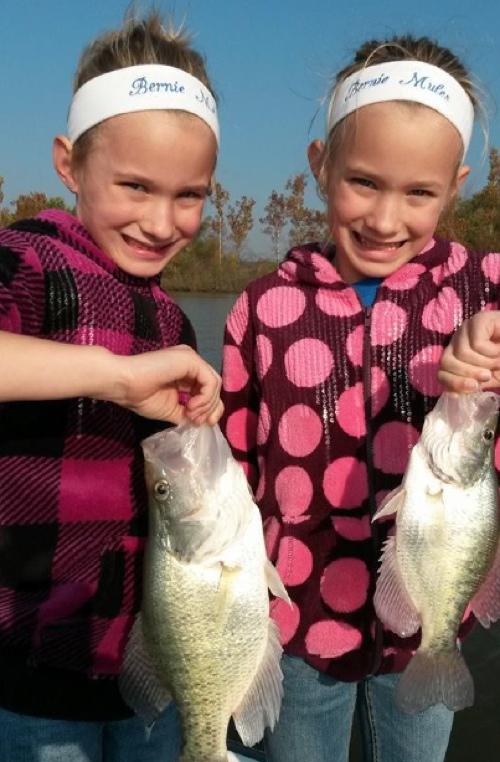
Missouri - One of the most catchable fish in Missouri waters, especially in the summer months, is the group known as panfish, and the peak catching time is now.
In late June and early July, concentrations of bluegills will be spawning along shallow lake or pond shores.
Look for craters of round light spots on the bottom, which are the nest sites.
Bluegills and sunfish relatives are excellent table fare, possibly better flavored than walleye. These panfish may be filleted or scaled, then rolled in seasoned flour and fried.
Jack Anderson and his wife of 42 years, Charlotte, settled in his boat and cruised to their favorite bluegill and crappie fishing hole. Anderson pointed out that his wife has matched casts with him ever since they made a honeymoon fishing trip to the Lake of the Ozarks back in 1973.
Like many Missouri anglers, the Andersons have been called panfish anglers, which is appropriate for people who primarily fish for bluegill, perch and crappie.
Charlotte said, " We like to fish for panfish because we like to eat what we catch. You can't get a better tasting fish than a crappie or bluegill."
On one of their latest fishing trips, the goal was to put enough fish in the boat for a couple of meals. In seconds after arriving at one of their favorite spots, they cast their hooks with earthworms. In less time it took to say, "I got one," Jack pulled in an 8-inch fighting bluegill. As he spoke, his wife hauled in another big bluegill. In less than an hour, they had caught about two dozen fish including a one-pound crappie.
Anderson said, " I have done a lot of bank fishing in my life, particularly when I had trouble with my back. Like anyone who fishes for panfish from the bank the biggest problem is getting your line far enough out to catch fish. I found by using a small sinker and a bobber works best."
It doesn't matter if the couple are fishing from the bank or in a boat, they catch their share of panfish and then some.
A closer look at Missouri panfish:
Green sunfish: State record is 2 pounds, 2 ounces taken from Stockton Lake back in 1971. Its back is dark olive with lighter sides. The gill cover lobe is black, except for light colored red margin. Six years would be a long life for green sunfish.
Bluegill: State record is 3 pounds taken back in 1963 from a pond. Like most of the panfish, bluegills provide good table fare. They may be best when coated with seasoned flour and fried in butter. The bluegill's fighting qualities are excellent. They can be taken on a wide variety of lures and bait.
White crappie: The state record is 4 pounds, 9 ounces taken in 2000 from a pond. It has the same general appearance as a black crappie except slightly more elongated. It also has sides of silver with shades of purple and seven to nine vertical bars. It's good on the table, but a notch lower on the culinary scale than the black crappie. They generally don't fight as well as the black crappie.
Black crappie: The state record is 4 pounds, 8 ounces, taken from a farm pond in 1967. The black crappie can live 10 years or longer. It has dark specks on sides than are both yellow and green. It offers good table fare. Black crappie are good fighters who prefer clearer water than the white crappie.
Panfishing techniques
For panfish, most anglers rely on small hooks tipped with minnows or worms. Spinners and small spoons work on panfish.
Fly fishing anglers have good luck with panfish species by casting small poppers to top feeding fish and using wet flies to drop into feeding zones.
Pan-fishermen will want to look for dropoffs during the summer. Still-fishing with a small jig or flyfishing with wet flies or small poppers is effective for bluegills.
With thousands of ponds, many large impoundments and streams to fish plus a season that never closes, Missouri pan-fishermen are ready for a summer of good fishing and great eating.
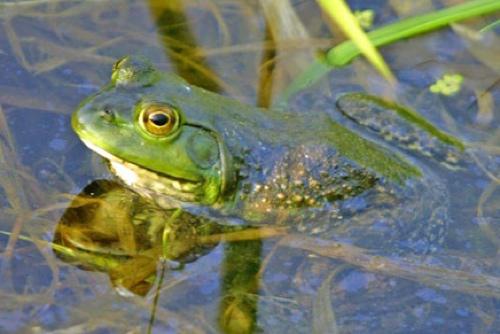
Frogging can be done with either a fishing permit or a small game permit. Children under the age of 16 and Missouri residents 65 years of age or older are not required to have a permit. The Wildlife Code of Missouri allows those with a fishing permit to take frogs by hand, hand net, atlatl, gig, bow, trotline, throw line, limb line, bank line, jug line, snagging, snaring, grabbing or pole and line. With a small game hunting permit, frogs may be harvested using a .22-caliber or smaller rimfire rifle or pistol, pellet gun, atlatl, bow, crossbow, or by hand or hand net. The use of an artificial light is permitted when frogging.
Missouri has two frog species that are legal game — bullfrog and green frog. Bullfrogs are larger and therefore more sought-after. The taste and texture of frog meat is similar to that of fresh-water fish. For frog leg recipes, visit the MDC website at mdc.mo.gov/node/15131.
The daily limit is eight frogs of both species combined. The possession limit allows you to have no more than 16 frogs at a time.
It's important to know once a frog is speared or shot, it must be harvested. The Wildlife Code of Missouri prohibits the release of a speared frog as "wanton waste" because the animal is not likely to recover. Any frog taken into actual possession, unless immediately released unharmed after being caught, is included in the daily limit.
Almost any place with enough water to float a canoe is likely to harbor at least a few frogs. Frogs can be found in farm ponds and huge reservoirs, creeks, drainage ditches and rivers, sloughs, marshes and swamps statewide.
Conservation makes Missouri a great place to hunt and fish, so grab a gig and visit a pond or simply grab a frog and head to the frying pan before the "frog days" of summer are over.

Leevon DeCourley has been entertaining audiences all over the Midewest and Southeast for the better part of the last ten years. The concert will be held at the Park's amphitheater behind the Visitor Center. The event is FREE.
Sam A. Baker State Park is located four miles north of Patterson on Highway 143 in Wayne County. For more information about the event, call the park at 573-856-4514.

To apply, visit the MDC website at mdc.mo.gov/node/11252 between July 1 and 31. MDC will post drawing results at the same website address from Sept. 1 through Jan 15. Applicants who get drawn will receive area maps and other hunt information by mail.
The hunts are open to Missouri residents and nonresidents and help achieve MDC’s deer-management goals for the state while providing additional hunting opportunities. Types of hunts include archery, crossbow, muzzleloader, historic methods, and modern firearms, plus youth hunts and hunts for people with disabilities.
Seventeen managed hunts will be held exclusively for hunters with disabilities. Eligibility varies by hunt so applicants should call the area hosting the hunt for details and to apply. Wheelchair-confined hunters may apply for more than one managed hunt offered at select conservation areas with a written request due by July 31 to: Missouri Department of Conservation, Attn: Managed Deer Hunts, PO Box 180, Jefferson City, MO 65102-0180.
All other hunters may apply for only one managed hunt per year. Hunters may apply individually or as groups of up to six, except for youth-only hunts. Youths age 11-15 years by the date of the desired hunt who are hunter-education certified may apply individually or with one other youth for youth hunts and must be accompanied on the hunt by a qualified adult mentor.
All applicants will need their nine-digit Conservation ID number to complete the application process. Conservation ID numbers are listed on hunting and fishing permits and Missouri Conservation Heritage Cards.
Resident or nonresident managed deer hunting permits are required to participate in managed hunts. These permits will be available to successful applicants beginning Sept. 1 from permit vendors, online through MDC’s e-Permits at mdc.mo.gov/node/10901, or through MDC’s free hunting mobile app -- MO Hunting.
Hunter education is required for firearms managed hunts, unless the hunter is exempt by age or other reason. Hunter education classes fill up quickly as fall hunting seasons approach. For more information on hunter education options and classes, visit mdc.mo.gov/node/3095.
MDC uses a weighted-preference-point system to give previously unsuccessful applicants an advantage in future drawings. Hunters who apply for the first time or who were drawn for hunts the previous year are statistically less likely to be drawn than those who entered but were not drawn in previous years.
Details about managed hunts can be found in MDC’s “2015 Fall Deer & Turkey Hunting Regulations and Information” booklet available in July at MDC offices and nature centers, from permit vendors around the state, and online at mdc.mo.gov.
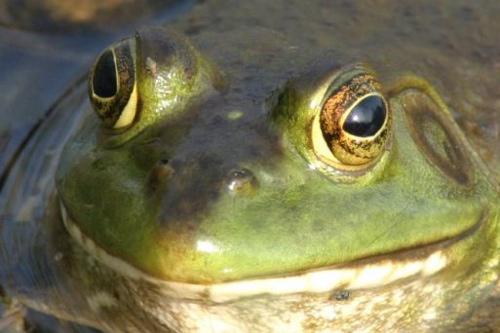
“Frog gigging, or frogging, is a great way to enjoy Missouri’s fish, forests and wildlife while putting good food on the table,” said Conservation Agent Andrew Mothershead.
The clinic will start with a classroom session on the basics of frog gigging safety, equipment, identification and regulations. Participants will go frogging with the help of MDC personnel and learn how to clean and cook their catch.
“Catching frogs can be a fun and exciting activity for the whole family,” said Mothershead. “If all goes right, frog legs are the reward after a successful night of gigging.”
Frogs can be legally harvested with either fishing or hunting permits, as long as the method matches the permit. With a fishing permit, frogs may be harvested by hand, hand net, atlatl, gig, bow, trotline, throw line, limb line, bank line, jug line, snagging, snaring, grabbing or pole and line during frog season. With a hunting permit, frogs may be harvested using .22-caliber or smaller rimfire rifle or pistol, pellet gun, bow, crossbow, atlatl or by hand or hand net.
This year’s frog season begins at sunset June 30 and continues through Oct. 31. The daily limit is eight bullfrogs or green frogs and 16 in possession. Children under the age of 16 and adults over 65 are not required to have a permit.
To register for the frog gigging clinic, or for more information, contact the Southeast Regional Office at 573-290-5730.
